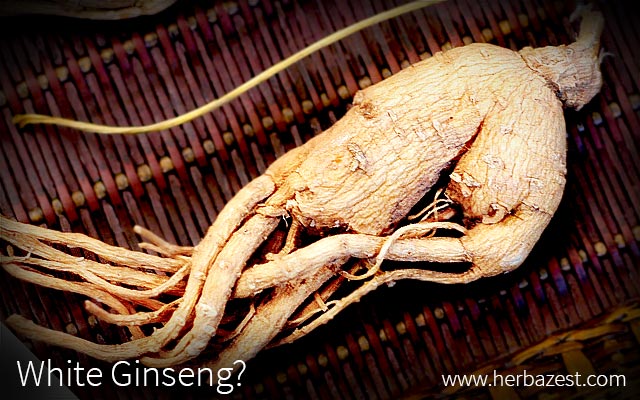White ginseng is the ginseng root that has been peeled and sun dried, but not steamed. When exposed to the sun, the roots of the ginseng plant get bleached and get a yellowish-white color, which is where white ginseng gets its name.
White Ginseng vs. Other Ginseng Preparations
The three well-known byproducts of the different methods of drying ginseng are white ginseng, red ginseng, and black ginseng. While white ginseng is the consequence of allowing raw ginseng to dry in the sunlight, red ginseng results from a steaming process, and black ginseng is derived from a repeated steaming and drying technique.
Depending on their production process, all types of ginseng differ in their particular chemical profile, which makes each one unique and useful in different ways. For example, after the root is steamed for two to three hours, the ginsenosides in red ginseng reach levels 2.5 times higher than in white ginseng. On the other hand, as a consequence of a long, repeated process of drying and steaming at different temperatures, the ginsenoside Rg3 content in black ginseng is enhanced.
Although many studies show that steamed ginseng is more beneficial, many people prefer white ginseng for being easier to get and cheaper. However, white ginseng benefits are unique. As simple as its drying process may be, white ginseng root has a particularly elevated content of protopanaxatriol class ginsenosides, compounds that aren't present in other types of ginseng.
White Ginseng Processing
Whether is American ginseng (Panax quinquefolius) or Korean ginseng (Panax ginseng), it takes four to five years for the plant roots to reach maturity. In order to obtain white ginseng, the underground stem or rhizome must be cleaned and the real roots should be cut. Either peeled or unpeeled, the fresh ginseng root is dried under the sun or with hot air, and kept for three years at room temperature before it is ready to be commercialized.
How to Use White Ginseng
Since Panax species has been around for thousands of years, various types of herbal preparations and supplements have been introduced, and all of them are made of different ginseng byproducts, including white ginseng. Although many people consider the taste of this root to be overbearing and displeasing, white ginseng tea can be easily found or prepared at home, and there are also liquid extracts, tinctures, powders, capsules, and tablets made of this specific type of ginseng.
Regardless of the type of ginseng, the standard daily dose should be around one to two grams.
White Ginseng Benefits
While research has indicated that its counterparts have a wide range of benefits, white ginseng has been shown to be potentially useful for treating certain health conditions.
A 2001 study at Kyung Hee University tested the antidiabetic activity of white ginseng in diabetic mice and discovered that it significantly reduced glucose levels in the animals.
Additionally, a 2014 study published by The Korean Society of Ginseng examined the treatment of asthma using white and red ginseng. It was found that both red and white ginseng have antiasthmatic effects; however, red ginseng was considered to be more beneficial.
White Ginseng Products
Since Korean and American white ginseng are not as popular as other types of dried ginseng, they are more affordable and can be purchased in larger quantities. Products such as white ginseng tea bags, capsules, extracts, and powder are available in herbal shops, as well as in online retail stores for a very reasonable price; however, the health value of these products is considered to be roughly one-fifth that of red ginseng products. Both American and Korean white ginseng are also commonly used in the cosmetic industry, such as in face creams and moisturizers that can be found in beauty shops.
White ginseng is a simple and inexpensive way to reap some of the benefits of the ginseng plant. However, in order to obtain maximum results, the use of red ginseng is recommended.
Sources
- Archives of Pharmacal Research, Comparisons between white ginseng radix and rootlet for antidiabetic activity and mechanism in KKAy mice, 2001
- Clinical Nutrition Research, Effects of Korean White Ginseng (Panax Ginseng C.A. Meyer) on Vascular and Glycemic Health in Type 2 Diabetes: Results of a Randomized, Double Blind, Placebo-controlled, Multiple-crossover, Acute Dose Escalation Trial, 2014
- Penn State Hershey Medical Center, Asian ginseng
- The Korean Society of Ginseng, Comparative study of Korean White Ginseng and Korean Red Ginseng on efficacies of OVA-induced asthma model in mice, 2014




